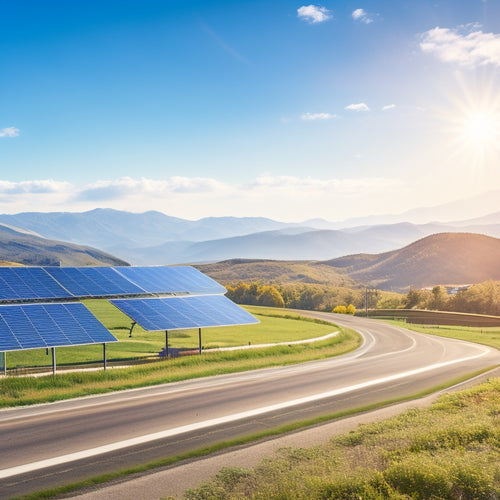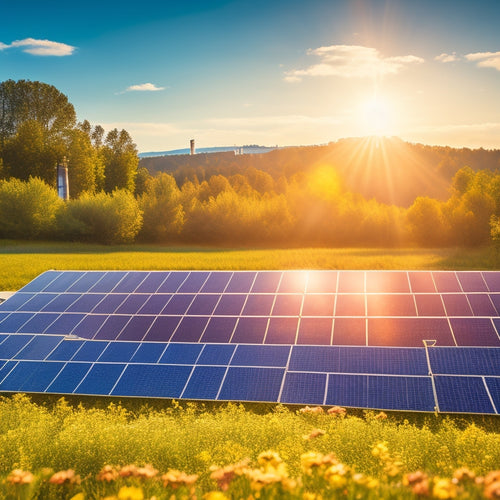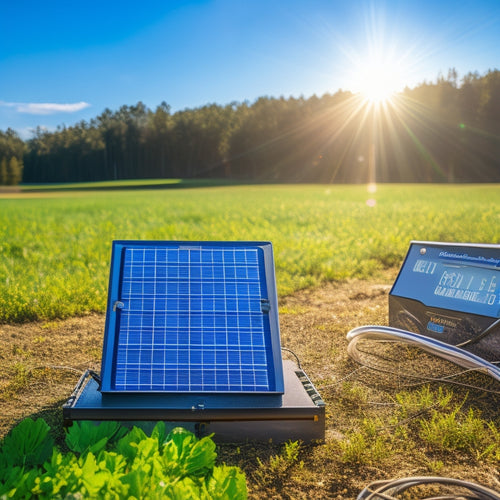
Why Inverters Matter for Your Renewable Energy System
Share
Your renewable energy system's performance and efficiency rely heavily on a critical component: the inverter, which converts DC power from your solar panels or wind turbines into usable AC power for your home or business. You need an inverter that's compatible with your energy source, properly sized for your system, and efficient in converting power. A high-quality inverter minimizes downtime, guarantees safe operation, and optimizes energy yield. With features like maximum power point tracking, real-time monitoring, and advanced safety protections, a well-chosen inverter can enhance your energy output and reduce losses. You're just starting to uncover the importance of inverters in renewably powering your life.
Overview
- High-quality inverters ensure efficient energy conversion, minimize downtime, and maximize energy output from your renewable energy system.
- Proper inverter sizing and assessment of energy requirements are crucial for effective energy capture and system performance.
- Inverter compatibility with renewable energy sources, such as solar or wind, is essential for optimal system operation.
- Advanced inverter technology offers real-time monitoring, peak energy harvesting, and high efficiency ratings above 95% for optimal performance.
- Inverter safety features and protections, such as overload and surge suppression, safeguard equipment and operators from potential hazards.
Understanding Inverter Functionality
Most renewable energy systems, particularly solar and wind power, generate DC power that requires conversion to AC power for grid connection or local use. You need an inverter to make this conversion happen.
Inverters come in different types, including string inverters, microinverters, and power optimizers, each with its own strengths and weaknesses. When selecting an inverter, you'll want to evaluate factors like efficiency, reliability, and inverter lifespan, which can range from 10 to 20 years or more, depending on the quality of the device and environmental conditions.
It's vital to assess your energy requirements and sizing to confirm the inverter can handle your daily energy needs. A high-quality inverter can guarantee efficient energy conversion and minimize downtime, giving you the freedom to utilize renewable energy and reduce your reliance on the grid.
Determining Inverter Compatibility
When sizing up an inverter for your renewable energy system, determining compatibility is vital to guarantee seamless integration and ideal performance.
You'll need to take into account the type of renewable energy source you're using, such as solar, wind, or hydro power. Different inverter types are designed to work with specific energy sources, so it's significant to choose an inverter that's compatible with your system.
When evaluating inverter options, verify the device's DC input requirements align with your solar panel voltage range, and take into account inverters that optimize power output across varying voltage conditions energy requirements and sizing.
Research various inverter brands and models to find one that matches your energy source and system requirements. Look for inverters with certifications from organizations like UL (Underwriters Laboratories) or IEEE (Institute of Electrical and Electronics Engineers) to confirm compliance with industry standards.
Inverter Efficiency and Performance
Enhance your renewable energy system's overall performance by scrutinizing the inverter's efficiency and performance metrics.
You'll want to evaluate the inverter's maximum power point tracking (MPPT) efficiency, which affects how well it captures energy from your renewable source.
Advanced inverter technology enables real-time monitoring and control for peak energy harvesting Advanced Inverter Technology, leading to significant power density increases for efficient energy conversion and lower costs.
Different inverter types, such as string inverters, microinverters, and power optimizers, have varying efficiency levels.
When choosing an inverter, look for high efficiency ratings, typically above 95%.
Additionally, assess the inverter's performance during grid connection, as it must synchronize with the grid's frequency and voltage.
A high-performance inverter guarantees a seamless grid connection, maximizing your system's energy output and reducing energy losses.
Safety Features and Protections
As you guarantee your renewable energy system operates at its best, it's equally important to safeguard people and equipment from potential hazards. You want to make certain your system is protected from electrical faults, overheating, and other risks. That's where safety features and protections come in.
| Safety Feature | Purpose | Benefit |
|---|---|---|
| Overload Protection | Prevents excessive current flow | Protects equipment from damage |
| Short Circuit Protection | Detects and interrupts faulty circuits | Ensures operator safety |
| Surge Suppression | Absorbs voltage spikes | Shields equipment from power surges |
Additionally, look for inverters with thermal management, grounding requirements, and safety certifications like UL and CE. System isolation and fault detection features can also help prevent electrical shocks and fires. By prioritizing safety, you can enjoy the freedom and independence that comes with utilizing renewable energy.
Inverter Maintenance and Monitoring
You'll want to prioritize inverter maintenance and monitoring to guarantee your renewable energy system operates at peak levels. This involves performing scheduled maintenance checks to identify potential issues before they become major problems, tracking performance data to enhance energy production, and analyzing error codes to quickly diagnose and resolve faults.
Regular inspections, such as checking for wear and tear and confirming connections are secure, can help prevent overheating and other issues. Additionally, monitoring battery health and updating firmware can also contribute to the system's overall efficiency.
Scheduled Maintenance Checks
Regular scheduled maintenance checks are vital to guarantee the ideal performance and longevity of your inverter in a renewable energy system.
You should perform routine servicing at regular intervals to identify and address potential issues before they become major problems. Scheduled inspections allow you to detect signs of wear and tear, clean or replace components as needed, and verify that your inverter is operating within its best parameters.
Additionally, confirming inverter compatibility with your battery chemistry and voltage requirements is essential to prevent damage and system failure.
By doing so, you'll minimize downtime, reduce the risk of unexpected failures, and maximize the overall efficiency of your renewable energy system.
Performance Data Tracking
Tracking performance data is essential for optimizing inverter maintenance and monitoring in your renewable energy system. You need to keep a close eye on your inverter's performance to guarantee it's running efficiently and effectively.
By tracking performance data, you can identify areas for improvement and make data-driven decisions to optimize your system's output. This is where data visualization comes in - it helps you make sense of complex performance analytics, giving you a clear illustration of your inverter's performance.
With performance data tracking, you can monitor key metrics such as energy production, system uptime, and alert thresholds. This enables you to take proactive measures to prevent downtime, reducing maintenance costs and maximizing your return on investment.
Error Code Analysis
By analyzing performance data, you've likely encountered error codes that require attention. These codes can indicate issues with your inverter, which if left unchecked, can lead to reduced energy production, equipment damage, or even complete system failure.
That's why error code analysis is a vital aspect of inverter maintenance and monitoring. When troubleshooting error codes, it's important to identify the root cause of the issue.
Inverter error diagnostics can help you pinpoint the problem, allowing you to take corrective action. Effective error code troubleshooting involves understanding the inverter's error code definitions, monitoring system performance, and implementing corrective measures to guarantee your renewable energy system operates at peak levels.
Optimizing System Performance
When designing a renewable energy system, one essential aspect is often overlooked: optimizing system performance. You want to guarantee your system operates at its full potential, maximizing energy yield and reducing waste. A critical component in achieving this is proper inverter sizing.
| System Component | Optimization Factor | Impact on Energy Yield |
|---|---|---|
| Inverter | Sizing | Up to 10% increase in energy yield |
| Panel Tilt | Angle adjustment | Up to 5% increase in energy yield |
| Cable Length | Minimization | Up to 3% increase in energy yield |
Frequently Asked Questions
Can I Use a Single Inverter for Multiple Renewable Energy Sources?
You can use a single inverter for multiple renewable energy sources, but it depends on the inverter type and its ability to handle renewable integration; hybrid inverters or multi-MPPT inverters are suitable for this purpose, allowing you to combine different sources efficiently.
Do Inverters Work With Dc-Coupled or Ac-Coupled Systems?
Ah, the eternal conundrum: DC or AC coupling? You decide, freedom-seeking pioneer! Inverters can work with both, but DC coupling means a single inverter for all sources, while AC coupling requires separate inverters for each - the choice is yours, rebel!
Are Inverters Compatible With Energy Storage Systems?
You'll find that certain inverter types, like hybrid inverters, are designed to seamlessly integrate with energy storage systems, ensuring maximum energy efficiency and allowing you to utilize your stored power whenever you need it.
Can I Install an Inverter in a Residential Area?
"When in Rome, do as the Romans do" - in this case, check local inverter installation regulations before proceeding. You can install an inverter in a residential area, but be aware that different types, like string or microinverters, have varying requirements and restrictions.
Are Inverters Resistant to Environmental Factors Like Humidity and Dust?
You'll find that most modern inverters are designed with inverter durability in mind, featuring strong environmental protection against humidity and dust, ensuring reliable performance and minimizing maintenance needs in various settings.
Ready to Buy
As you steer through the intricate terrain of renewable energy systems, think of your inverter as the conductor of a finely tuned orchestra. Each component plays a crucial role, but the inverter harmonizes them all, ensuring efficient energy conversion and flow. Without it, your system would be a discordant mess, wasting precious energy and potential. By choosing the right inverter and maintaining it properly, you'll create a harmony of sustainability that echoes throughout your entire operation.
Related Posts
-

Is Switching to Green Energy Solutions Easy
Switching to green energy solutions isn't just easy; it's also beneficial. You can greatly cut utility costs and enjo...
-

Advantages of Solar Generating Systems Over Traditional Energy
Solar generating systems provide several key advantages over traditional energy sources. You'll experience lower long...
-

Choosing the Right Solar Power Charge Controller
Choosing the right solar power charge controller is crucial for maximizing energy efficiency and extending battery li...


